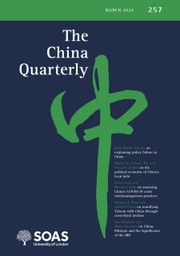No CrossRef data available.
Article contents
Corruption and Market in Contemporary China. By YAN SUN. [Ithaca, NY: Cornell University Press, 2004. 272 pp. Hard cover $49.95, ISBN 0-8014-4284-2; paperback $21.00, ISBN 0-8-8014-8942-3.].
Published online by Cambridge University Press: 21 March 2005
Extract
In Corruption and Market in Contemporary China, Yan Sun seeks to describe, in qualitative terms, corruption in post-Mao China and assess its consequences. Corruption is not, she argues, a unitary phenomena but rather consists of a variety of different forms of malfeasance whereby officials use the public authority granted them by right of their positions to seek private gains. Differences in form imply differences in result. Thus, we might presume it makes a difference if an official loots the treasury and absconds to the Cayman Islands or if she accepts a minor bribe in return for granting a business licence to an entrepreneur who goes on to establish a flourishing business empire.
In trying to describe Chinese corruption, Sun faces a Herculean task. Since 1979, the Ministry of Supervision and the Party's Discipline Inspection Commission have disciplined three million cadres and the judicial Procuratorate has prosecuted one million cases of economic and disciplinary crime. Even given detailed and systematic data, the task of cataloguing the multitudinous forms of corruption and then characterizing them into a manageable typology would be a formidable analytic task. Such data are, however, lacking. Sun is therefore forced to turn to case data drawn from a variety of compilations and collections. These data are problematic – as Sun recognizes – because of sampling error and selection bias.
Using her database (which consists of approximately 1,300 mostly senior-level cases), supplemented by data from official and unofficial Chinese sources, Sun breaks corruption down into two major categories, transactive and nontransactive, differentiating between exchanges between state officials and private interests (e.g. bribery), and the theft of state assets by officials (e.g. embezzlement). She then disaggregates these categories into 11 subcategories and 27 specific forms. She further differentiates between two periods (pre-1992 and post-1992) and breaks corruption down along regional lines.
- Type
- Book Reviews
- Information
- Copyright
- © The China Quarterly, 2005


